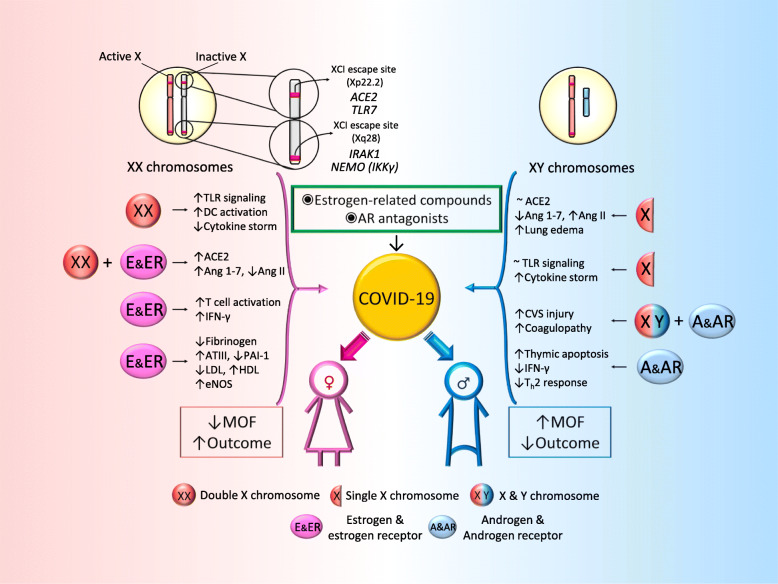Fig. 1.
Main mechanisms responsible for increased immune activity in females, providing a survival advantage in COVID-19. In females, the second X chromosome is randomly silenced during X chromosome inactivation (XCI) in order to minimize duplication of proteins encoded by X-linked genes. However, several genes bypass this inactivation. The ACE2 gene location on Xp22.2 is known to avoid X-inactivation, contributing to phenotypic differences between sexes. IRAK1 and IKKγ are also encoded on the XCI escaping sites, which may confer an advantage in responding to and resolving SARS-CoV-2 infections in females. The X chromosome has numerous genes involved in immunity. Naturally occurring variations in one gene copy might result in two distinct alleles with different regulatory and response capacities, suggesting that females, but nor males, may not only avoid the effects of deleterious gene mutations, but also benefit from added physiological diversity when facing new immune challenges, such as SARS-COV-2 infections. Estrogen and estrogen receptor signaling play a crucial role in both innate and adaptive immune responses as well as in tissue repairing processes during respiratory virus infection. Sex-based targeted therapeutic and interventional approaches such as estrogen-related compounds and androgen receptor antagonists may be considered in patients with COVID-19. ACE2: angiotensin-converting enzyme 2; TLR7: Toll-like receptor 7; IRAK1: Interleukin-1 receptor-associated kinase 1; NEMO (IKKγ): NF-kappa-B essential modulator (inhibitor of nuclear factor kappa-B kinase subunit gamma); DC: dendritic cell; TLR: Toll-like receptor; Ang 1–7: angiotensin 1–7; Ang II: angiotensin II; IFN-γ: interferon gamma; ATIII: antithrombin III; PAI-1: plasminogen activator inhibitor-1; LDL: low-density lipoprotein; HDL: low-density lipoprotein; eNOS: endothelial nitric oxide synthase; CVS: cardiovascular system; Th2: Type 2 helper T cells; MOF: multiorgan failure

